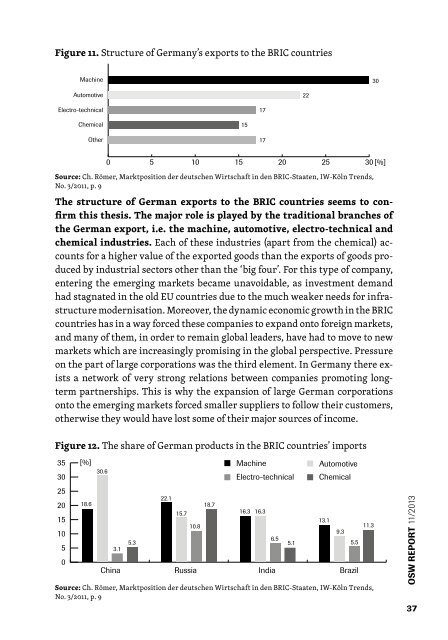Full text in PDF - OSW
Full text in PDF - OSW
Full text in PDF - OSW
You also want an ePaper? Increase the reach of your titles
YUMPU automatically turns print PDFs into web optimized ePapers that Google loves.
Figure 11. Structure of Germany’s exports to the BRIC countries<br />
Mach<strong>in</strong>e<br />
30<br />
Automotive<br />
22<br />
Electro-technical<br />
17<br />
Chemical<br />
15<br />
Other<br />
17<br />
0 5 10 15 20 25 30[%]<br />
Source: Ch. Römer, Marktposition der deutschen Wirtschaft <strong>in</strong> den BRIC-Staaten, IW-Köln Trends,<br />
No. 3/2011, p. 9<br />
The structure of German exports to the BRIC countries seems to confirm<br />
this thesis. The major role is played by the traditional branches of<br />
the German export, i.e. the mach<strong>in</strong>e, automotive, electro-technical and<br />
chemical <strong>in</strong>dustries. Each of these <strong>in</strong>dustries (apart from the chemical) accounts<br />
for a higher value of the exported goods than the exports of goods produced<br />
by <strong>in</strong>dustrial sectors other than the ‘big four’. For this type of company,<br />
enter<strong>in</strong>g the emerg<strong>in</strong>g markets became unavoidable, as <strong>in</strong>vestment demand<br />
had stagnated <strong>in</strong> the old EU countries due to the much weaker needs for <strong>in</strong>frastructure<br />
modernisation. Moreover, the dynamic economic growth <strong>in</strong> the BRIC<br />
countries has <strong>in</strong> a way forced these companies to expand onto foreign markets,<br />
and many of them, <strong>in</strong> order to rema<strong>in</strong> global leaders, have had to move to new<br />
markets which are <strong>in</strong>creas<strong>in</strong>gly promis<strong>in</strong>g <strong>in</strong> the global perspective. Pressure<br />
on the part of large corporations was the third element. In Germany there exists<br />
a network of very strong relations between companies promot<strong>in</strong>g longterm<br />
partnerships. This is why the expansion of large German corporations<br />
onto the emerg<strong>in</strong>g markets forced smaller suppliers to follow their customers,<br />
otherwise they would have lost some of their major sources of <strong>in</strong>come.<br />
Figure 12. The share of German products <strong>in</strong> the BRIC countries’ imports<br />
35 [%]<br />
Mach<strong>in</strong>e<br />
Automotive<br />
30<br />
25<br />
30.6<br />
Electro-technical Chemical<br />
22.1<br />
20 18.6<br />
18.7<br />
15<br />
15.7<br />
16.3 16.3<br />
13.1<br />
10.8<br />
10<br />
9.3<br />
6.5<br />
5.3<br />
5.1<br />
5<br />
3.1<br />
5.5<br />
0<br />
Ch<strong>in</strong>a Russia India Brazil<br />
Source: Ch. Römer, Marktposition der deutschen Wirtschaft <strong>in</strong> den BRIC-Staaten, IW-Köln Trends,<br />
No. 3/2011, p. 9<br />
11.3<br />
PRACE <strong>OSW</strong> REPORT <strong>OSW</strong> 09/2012 11/2013<br />
37


